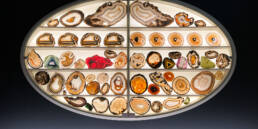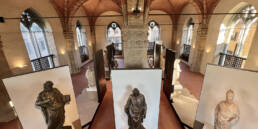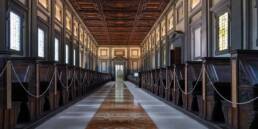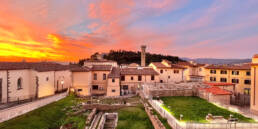This is a guest post about the area around Santa Maria Novella train station as convenient home base location in Florence, with an itinerary.

Florence, Italy – most people who have been there long to return. I, therefore, am like most people in that regard.
Unlike most people (I would imagine) my most vivid images of Florence come from the area near the main train station, Santa Maria Novella Station (AKA Firenze SMN). I typically arrive in the grand city of Firenze (Florence) by train and arrange lodging nearby, since the Firenze SMN train station is an ideal gateway to just about anywhere else I might like to visit in the rest of the country.
The train station reminds me of a capital letter “T”. When you step off the train, simply follow the river of people toward the front of the station. Once you get to the front of the station (the top of the “T”), you really can only get out of the station by heading right or left. I always head left, and emerge from the station on the southeast corner.
Just beyond the immediate view of 21st-century vehicles waiting outside the station, the open grass unfolds and the grandeur of Santa Maria Novella church across the street welcomes you. Each time I arrive in Florence, young people have been stretched out in the grass in front of the station; it is a popular resting and waiting spot, and one of the few open grassy spaces in the center of town. Some of those people must be waiting for the very popular sightseeing bus tour of Florence, run by City Sightseeing Firenze. The bus for the 60-minute tour of Florence begins right there at the SMN station. If you only have one day to see Florence, I can think of no better recommendation than to begin your day on one of those tours, and then double back on foot to any place that ensnared your imagination.
It is a short walk to the tip of the grassy area in front of the station, to the Piazza della Stazione. At this point, with luggage firmly in hand, I dash across the large intersection of Via Valfonda and Largo Fratelli Alinari.
It is here, where Largo Fratelli Alinari becomes Via Nazionale that I usually find a hotel for my stay. The buildings along this street are alive and yet content with their own fascinating histories. A palace that was built for the Fratelli Alinari (the Alinari brothers) now contains Hotel Cosimo De’ Medici (at Largo Fratelli Alinari, 15). A few more steps down the road is Hotel Machiavelli Palace (at Via Nazionale, 10) in a building that was previously a convent. When trying to find these hotels, do not look for a giant “Holiday Inn” style sign out front – read the signs along the walls of the buildings and inside the alcoves near entrances. Also, most of these hotels are in historic buildings, and not in dedicated, stand-alone buildings that are easy to distinguish as hotels. Allow yourself time to stroll, read the signs, and don’t get discouraged if you have to double-back to read the signs again.
The views from the windows of the rooms along this street are traditionally Florentine. If you are lucky enough to have windows facing south, you might have a view of the dome of the Medici Chapels or Brunelleschi’s dome for the Duomo.
Once I’m settled in to my hotel room, it is only a block or two to some of the best reasons for a lover of Italian food, crafts, and clothing to be in Florence. Heading east on Via Nazionale two blocks, at the intersection of Via dell’Ariento, begins the San Lorenzo Street Market. Dozens of vendors set up outdoor market stalls daily along this street to offer their treasures to locals and tourists alike.
As you walk down Via dell’Ariento, you will see the back of another of Florence’s wonders: the Mercato Centrale. The building housing Mercato Centrale indoor market is large and plain, yet unmistakably aromatic and lively with little truck deliveries of fresh produce, local wines, and other treasures from the area. Inside, the vendors speak quickly and move at a modern pace. I have never seen meat so fresh (or still so whole), cheese so mysterious, nor balsamic vinegar so old and in such tiny bottles as what I see in the Mercato Centrale. Check the US Customs website (http://www.cbp.gov ) before your trip to Italy to find out if you’ll need any special packaging or certification from the Italian vendors, if you plan to bring back food from here.
As the sun sets in Florence, I love to explore the tiny medieval streets with their impossibly narrow sidewalks. It is a useful skill to learn when to walk on the 24 inch sidewalks and knowing when it’s safe to walk in the street. On these walks I find the tiny telephone booth-sized jewelry, ceramics, and food shops that I will seek out the following day. I note the opening times on the little doors to these shops, and automatically add 90 minutes in my head. Written and posted opening hours in Italy are largely ceremonial – business owners feel obligated to post them, but rarely follow them.
Of course, more wonders of Florence are just steps from this area. The Galleria dell’Accademia (where Michelangelo’s David resides) is to the east. The Medici Chapels Museum, the Duomo, the Uffizi Museum (see arttrav podcasts for the uffizi), and most of the other famous sites are a short walk southeast. The Fortezza da Basso (still standing since 1534 and where so many Florence trade shows are held today) is just north.
This area between the Santa Maria Novella Train Station and Mercato Centrale makes me feel connected to everything else, and to everyday life, in Florence. It is ideal as a hub for your Italian vacation – or for an indefinite stay.
Jennifer Johnson is the author of the Thinking Italy Blog and owner of www.ThinkingItalyTravel.com. Jennifer resides in the US, but when she’s not in Italy, she’s Thinking Italy.
Sign up to receive future blog posts by email
Related Posts
January 30, 2024
Florence Museum News 2024
January 5, 2024
The Architecture of Michelangelo’s Laurentian Library
July 19, 2023





